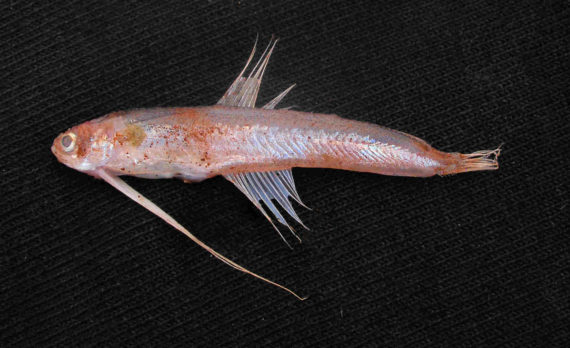East Pacific Codlet, Bregmaceros bathymaster
 East Pacific Codlet, Bregmaceros bathymaster. Fish regurgitated by a Pacific Red Snapper taken in 92 m (300 feet) water, July 2011, off Point Palmilla, Baja California Sur. Length: 5.0 cm (2.0 inches).
East Pacific Codlet, Bregmaceros bathymaster. Fish regurgitated by a Pacific Red Snapper taken in 92 m (300 feet) water, July 2011, off Point Palmilla, Baja California Sur. Length: 5.0 cm (2.0 inches).
The East Pacific Codlet, Bregmaceros bathymaster, is a member of the Codlet or Bregmacerotidae Family, that is also known as just Codlet and in Mexico as bacalete de Pacifico oriental. Globally, there are eleven species in the Bregmacerotidae Family, all in the genus Bregmaceros, of which three are found in Mexican waters, two in the Atlantic and one in the Pacific Ocean.
The East Pacific Codlet has a small elongated slightly compressed cigar-shaped body. They are reddish-brown dorsally and silvery-white ventrally. Their fins are translucent. Their head is short with disproportionately large eyes. Their mouth opens at the front, extends to mid-eye, and is equipped with one or two series of minute slender teeth on each jaw. Their anal fin has a long base and is similar to the second dorsal fin with 44 to 50 rays; their caudal fin is small and lunate but is well developed and separate from the anal and dorsal fins; their first dorsal fin has 1 spine and is long and originates on top of the rear portion of the head (known as the occipital ray, not pictured above); their second dorsal fin has 44 to 49 rays and is very short; their pectoral fins are short and located high on their sides; and their pelvic fins have 5 to 7 rays, with the outer 3 are long, thick and free and extend well past the anal fin origin, and the inner 3 or 4 rays are short and branched. Their body is covered with small, smooth, and thin scales. Their lateral line is high on the back under the dorsal fin base.
The East Pacific Codlet is a pelagic species found over soft bottoms on the continental shelf and slope at depths between the surface and 1,225 m (4,000 feet). They reach a maximum of 10.0 cm (3.9 inches) in length. They are believed to be vertical migrators moving toward the surface at night to feed on plankton and retreating toward the bottom to avoid predation during the day. Reproduction is oviparous with planktonic eggs and larvae. The East Pacific Codlet is poorly studied with very limited information available about their lifestyle and behavioral patterns including specific details on age, growth, longevity, movement patterns, diet, habitat use, and reproduction.
The East Pacific Codlet is a resident of Mexican waters of the Pacific but has a limited distribution being found from Magdalena Bay, Baja California Sur, southward along the southwest coast of Baja, in the southern half of the Sea of Cortez, and along the coast of the mainland south to Guatemala.
The East Pacific Codlet cannot be confused with any other species due to the occipital ray on its head, its coloration and overall body profile.
From a conservation perspective the East Pacific Codlet is current considered to be of Least Concern with stable widely distributed population. Due to their small stature and rarity, they are of limited interest to most.